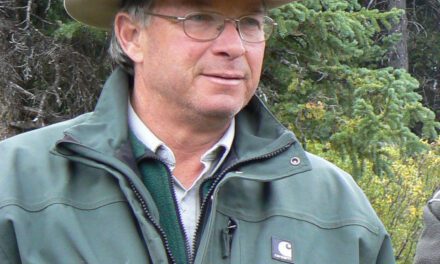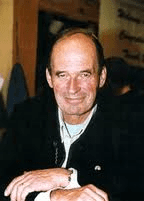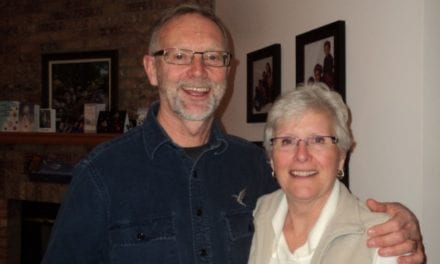Thank you to the Whyte Museum of the Canadian Rockies for granting permission to the Park Warden Service Alumni to post this interview on our website.
Park Warden Service Alumni Society
Oral History Project – Phase 8
Interview with Al Stendie, Feb. 4th, 2019
Interview conducted by Mary Dalman
MD: This is an interview (over the phone) with Al Stendie, Feb. 4th, 2019, and Al’s up at home in Mayerthorpe, Alberta with his wife, Nina. Just to get going Al, can you tell us your place of birth and when you were born?
Al: Yes, I was born Nov.11, 1945, very early in the morning in Kelvington, a small east-central town in Saskatchewan. I am the last child born in a family of my mom and dad and three siblings, one sister and two brothers. My mom was of British Isles origin and came from an Ontario farm to the Kelvington area in 1921 as a child when my grandfather had taken a homestead. My father came from Norway after teaching school for about ten years. In 1929 he homesteaded in the same area that my mom lived and they were married in the early ‘30s.
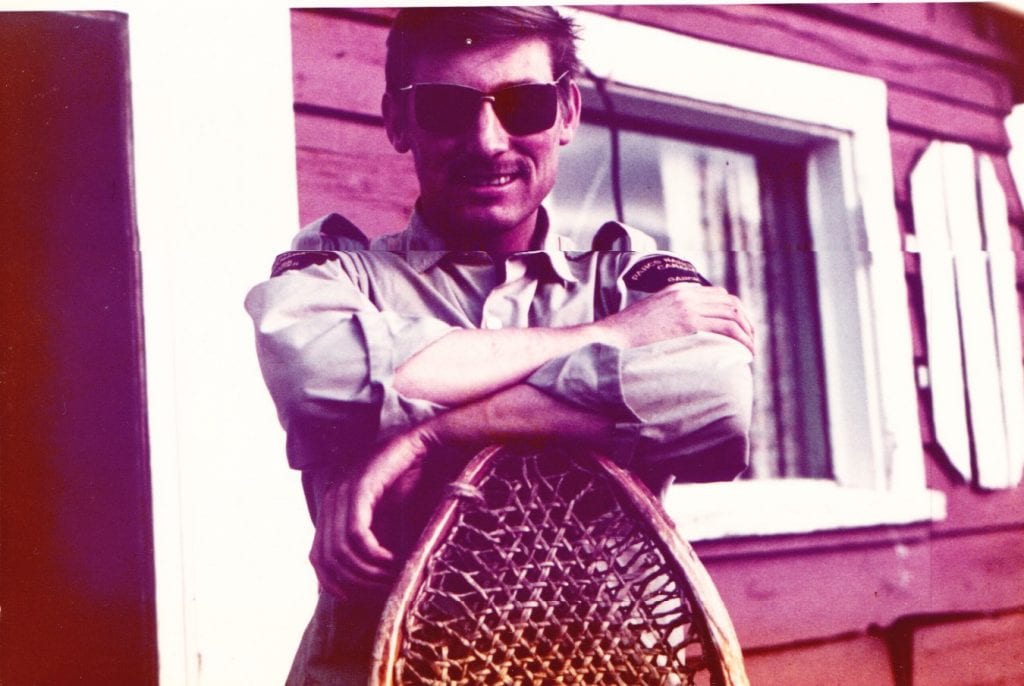
I grew up on a small mixed farm in rolling hills of boreal forest/aspen parkland countryside with small lakes and streams. We were about 15 miles northeast of the town of Kelvington. Life was simple – we didn’t have a lot of money, but we lived happy busy healthy lives. Most of the food came from the farm and was fresh and wholesome. The work was hard to do and we travelled and worked with horses. We used vehicles some of the spring, summer, and fall, but in the winter we used horse travel. There was no telephone or electricity, but we had water from the well, and wood from the woodpile. We had battery style AM radio which brought us the news of the world, country, and province. The mail came to a post office about 5 miles away from home once a week and there was also a small store there. People were quite close to each other and visiting was a pastime in the evenings, afternoons and on Sundays. There were card parties, all kinds of dances and get-togethers so everyone kept in touch. The schools served as the main venue and also the community halls. My Dad played the violin very well as he had trained as a classical violinist in Norway, but then he later came to country music. The rest of us learned to play instruments and that was a big part of our life. Our school was actually 5 miles away from our home and it made for some cold trips in the wintertime. We travelled to school with horses, snowshoes, skis, bikes, and occasionally by car in the spring. It was a one-room school house with a barn for the horses, and a large yard with a ball diamond in it, and a couple of outhouses. I went to all 8 grades with the same lady teacher – September ’51 to June ’59. The year I was in the 8th Grade there were only 10 kids left in the school, so the District closed the school and began bussing everyone into the town of Kelvington. The bus travel there was about 2 hours each way to town and I still had three miles to get to the bus. We were back in the woods! I attended the Kevington High School from Sept. ’59 to ’64 when I graduated. It was a shock to my system to go into the town school because there were a heck of a pile of teenagers and lots of teachers. That first year I definitely had to get used to everything. But I got involved in other things, and one of the things I felt good about was that we started a little band and the Legion sponsored it. It was about the same time the Beatles were coming out. We played at dances and on TV shows and all over Saskatchewan practically. We went down to “old-time dances” and we played for lots of graduations, weddings, and that sort of thing. I played guitar and accordion. When I graduated in ’64, I travelled to Rocky Mountain House with my brother and his wife, and got a job as a campground attendant at Crimson Lake Provincial Park. In trying to get into the parks system, I worked there from July to Sept. ’63, and again from July to September ’64. It’s just north of Rocky Mountain House. It’s a nice little park. That fall I worked for an oil construction company and then I got on an oilrig.
I travelled with that crew from the oil rig to Colonsay, Saskatchewan, and worked from January ’65 to July ’65. We were doing the freeze-holes for one of three shafts for the potash mine, and from there back to Alberta and on the rigs again August ’65 to December of ’66. I had had about enough of that, so I went home for a while, and I worked at my uncle’s lumber camp in January to April by Hudson’s Bay, Saskatchewan. After that I took a job at a Provincial Park, Greenwater Lake Provincial Park, near our home, and was there May to August of ’67. In September of ’67 I applied for the Renewable Resources 2-Year Technology Program at the technical school in Saskatoon. I went off to school, not really prepared. I had a new car but I didn’t have any money, but three of us shared a little attic suite and somehow made it through. I graduated in May of ’69, receiving a diploma from the Renewable Resources Technology Program in Applied Arts and Sciences school in Saskatoon.
MD: “How did you become involved in the Warden Service?”.
I first got involved with the warden service by sitting in on an interview for Prince Albert National Park in the spring of ’69 with Chief Warden Ben Roper and Superintendent John Mayfair and Personnel Officer Al Barr from Regional in Calgary. They awarded me a seasonal position, and though I had some other offers, I considered it to be a much better thing for me to pursue. I was the only young fella they had at P.A. because all of the wardens were war vets, Hal Shepherd, Ron Davies and Jack Leader, and all those fellas really treated me well.
MD: “What made you want to join the Warden Service?”
I didn’t really know much about National Parks. I was kind of concentrating on getting something in Saskatchewan like being a Conservation Officer, but I did research about the National Parks before I went on an interview – not thinking it was necessarily a job I would get. I won two other competitions for Provincial Parks, but the pay and the job locations weren’t as good, so I took the National Parks job. I considered it a privilege to get on with National Parks. Out of college that year, there were only two of us that got on – Greg Keesey and myself. He went firstly to Kootenay, I think. And I think the next year out of that school, Parks got about a dozen guys, including Gord Anderson in ’69. Then in 1970, Parks hired a lot of guys from that course. I was at Prince Albert for two summers – ’69 and ’70 – and then went to Jasper in the fall of 1970.
At the start I wanted to go to other parks such as the Maritimes and move around a bit, but once I got to Jasper and began to work with the diversity of the job in such a large operational park, it kept up my interest in my changing functions and also the training opportunities to upgrade what I was doing. So I kept kind of moving up in Jasper, and that was pleasing to me. There were different Chiefs coming to me and trying to get me to take a Chief position, but I didn’t figure I was made of that kind of stuff. It’s comforting to know they did, but you’ve got to kind of know yourself too.
MD: So would you say Jasper was your favourite then?
Al: No…I loved PA, I could have stayed there my whole career there too. But generally I think if I was anywhere in the National Parks system, I would have enjoyed it.
MD: What were your main responsibilities:
The general warden duties were to carry out the law enforcement, public safety, and resource management. Along with doing these duties, there was an expectation of maintaining all the facilities, equipment, travel modes, and tools, along with administration and recording, reporting and submitting documents to back up operational duties, and to train and educate to better your work efforts. So the summer of ‘69 I was on general duties throughout the park with the senior wardens who were kind of taking me under their wing for doing the job at Prince Albert. Like I say, they were all older fellas – it was retirement time for most of the veterans, which those wardens were, and so being born in ’45, I lucked into another good spot, getting on quite easily with those guys. In ‘70 I was assigned Waskesiu District, and that was because Ron Davies had a cast on him from chest to toe because he had hip operations. I kind of muddled through that, and got more experience under my belt with the boats and the general warden duties. Then when I went to Jasper in September of ’70 to April ’71, I was assigned to Pocahontas District with the station District Warden Abe Loewen. It was the full range of duties and I was still getting used to the park and what was to be done. April ’71 to July ’71, I was assigned to be the Cavell District warden with Toni Klettl, and then in June and July, I was the Tonquin Valley warden, and that was the first of my horse work. I was thrown onto my duties there with 3 horses – one riding and 2 for packing. From August ’71 to May of ’74, I was the Blue Creek District Warden on the North Boundary, which was the time of my life. There I usually had 4 horses. Wintertime meant patrols over 10 days with skidoos and trailers, snowshoes and skis, with the rest of the time we were in schools at the Palisades Centre or on winter alpine mountaineering trips.
From June ’74 to December ’77, I was Maligne Lake District Warden, and I moved out to the highway station. There was a full range of duties, but I did work for Resource Management Assistant Chief so I carried out resource management projects, as well as the station and my duties in that area. About that time (1975), I was made Land-use Officer for the whole park, and for 2 years we identified and worked to remediate about 160 disturbed sites (old dumps, industrial sites etc). I had two staff in the summertime, a seasonal warden and a tower man on the Bald Hills tower. I also worked with Betty Beswick on the Harlequin Duck Nesting Area Study, which established their easterly-most range on the Maligne River.
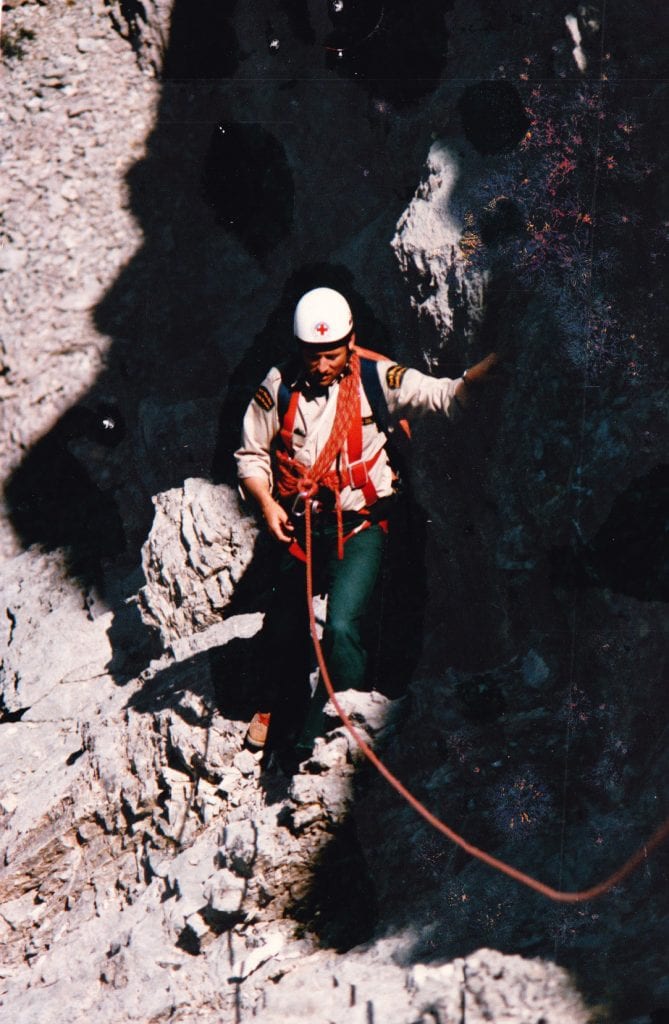
While at Maligne district I was under resource management with Bob Haney. Bob put me on a project to do during the long winter months. It was a paper on setting horse use nights at the horse campgrounds in the backcountry in the park. We were using the project methods of botanist George Scotter for quality and quantity of horse food and grazing in the Tonquin Valley. We got all grazing areas for users such as wardens and outfitters and them put on maps to calculate how much grass and what type, as well as wildlife stats. The project results were submitted with horse user nights for each site. Then the meetings started. The outfitters were very upset with me and even a few wardens were. A short time later a contract was let and a botanist carried out a study for three years. I later found out a few years later it was several hundred thousand dollars to come out with a very close conclusion regarding the number of horse user nights that I had come up with in my duotang report! Oh well!
I was really lucky because I got some of the prime spots too. I loved Blue Creek and thought I was on top of the world when I got Maligne Lake. Mac Elder was instrumental in getting me to Maligne Lake. He was the boss of the law enforcement / operational end of it in Jasper townsite, but he had spent the most time at Maligne Lake. He had the record for there at eight years or something.
The Warden office was within the Parks Administration Office, which is now the Visitor Centre in Jasper townsite. Everyone from the superintendent to clerks worked out of there, and we kept bear traps right in the parking lot. Mac Elder was the guy who used to go for the Warden mail from the Post Office. The Superintendent moved down to the building along Patricia Street, and though it was only about two blocks, but it would take Mac all morning to get down there and back because he knew everybody in town. He’d be talking to this one, and he’d turn around and get going and only make it about ten steps before he was talking to somebody else. They’re the guys that we learned from and grew into the job with, and we’re very thankful for them – lots of characters. And later, the move of the Warden office to the old hatchery by Maligne River was heavenly.
Don Dumpleton was Chief Warden and in December of ’77 he moved me to Sunwapta Station because it was a pretty big station – a lot of guys and a lot of programs going on there, but he didn’t have anybody to kind of lead them, so he moved me there. Bruce McKinnon had just moved down east I believe to Georgian Bay Park, so he placed me down there. I wasn’t really pleased in going, because I’d spent some time in the Icefields area and it always seemed fairly gloomy to me – cold and ice. When we arrived there with our truckload of furniture and stuff from Maligne Lake, the power plant was out because it was so cold that the fuel was gelling up, so my first evening I pretty well spent in the power plant shed helping the mechanic and Darro Stinson fix the power plant. Darro said “Welcome to 45, Al.” That wasn’t a really pleasant move for me. I was there from January of ’78 to October of ’82. During that time, they developed a Senior Warden position and there was one in Jasper and one in Banff, and because of where I was at, I got the first Senior Park Warden position in Jasper Park. More came and went, but I generally oversaw about three permanent wardens and a couple of seasonals, and they also assisted from that station into the Brazeau backcountry warden area. The work was interesting at Sunwapta – we controlled the highway conditions, clearing and closures, as well ski reports and snow research. We also oversaw the operation of the “Avalauncher” (a gas powered explosives rifle), a 105-calibre Howitzer recoilless rifle, and hand charges for triggering controlled avalanches. So Sunwapta didn’t turn out all that bad – it was pretty interesting and we made a bunch of changes. I always had wardens with me at the station that were well-trained with public safety talents which I was thankful for. But now there’s no changes to the station – ‘cause it’s gone.
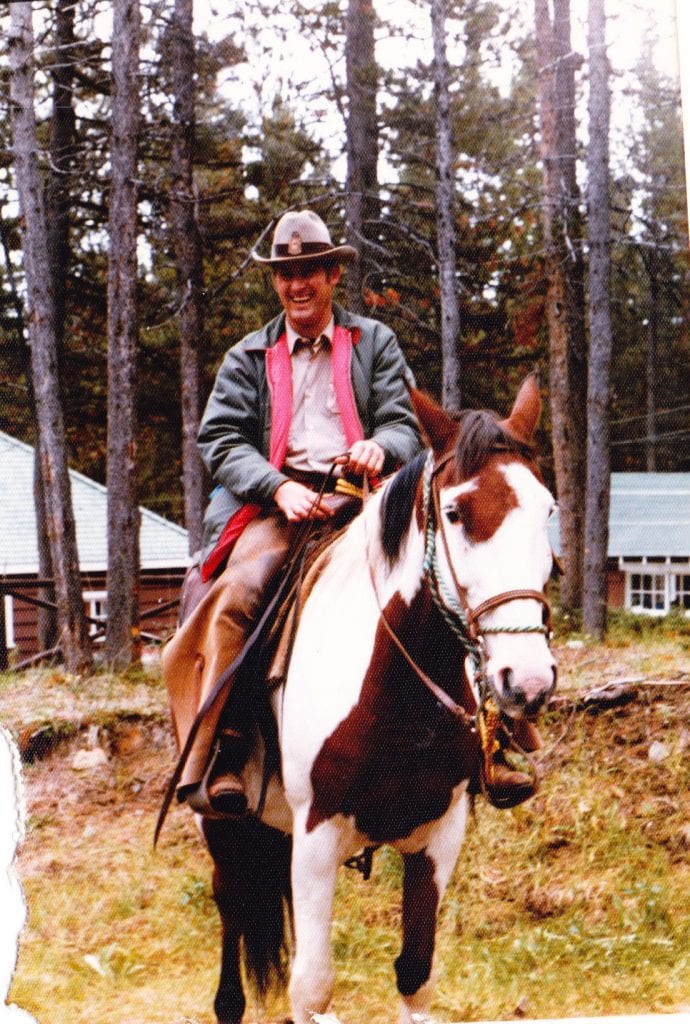
Al Stendie riding Boothlegger, Jasper National Park.
After 12 years working away from town, In November of ’82, I started in Jasper town due to the fact I had a wife and small daughter, I thought it was time to finally come in. I was at headquarters at the Warden station at Maligne River and worked for the Law Enforcement Assistant Chief Warden and I was Senior Park Warden in charge of operations – that was all the daily duties, all the law enforcement functions that went on in the park, and I oversaw about twelve seasonal and permanent wardens at that time. That went on until about May of ’87. In June of ’87 I just moved across the way to the Resource Management building as the Senior Park Warden because the position brought on more duties – there was one in each function after that. I was put in charge of the Environmental Assessment, water quality and pollution, and I oversaw the fish and wildlife wardens, and later Wes Bradford took over that role. In June of ’93, I stayed Senior Park Warden but was involved with air and water quality, and pollution control. We started doing quite a bit of research with the air quality at that time, as there hadn’t been much done in Canada yet, and worked with this scientist from Atmospheric Environment in Edmonton. We put out a paper after monitoring the CN exhaust in the townsite. We set up monitors and we also did the campgrounds because we were having a lot of problems with asthmatic people – it was coming right in there and it made people sick, with air quality like downtown L.A. in the summers. We actually did a little paper on it, and I spent some time at International air quality conferences in the States and at Waterton Park. I got kind of interested in airsheds and this type of thing.
I contributed to the establishing the Airsheds (Airshed: A geographical boundary for air quality standards) with Atmosphere and Environment monitoring that we put in from Wabamun to Jasper Park and then they all met – federal, provincial, and municipal, and oil and gas, timber – and everybody got together and they put in so much funding for each one of them and set up monitoring systems for air quality that are still going today. I haven’t checked on them lately but there were sites all along through the pine forests in Jasper and also alfalfa fields – there are some right by where we lived on our farm by Niton Junction.
MD: So you were on the ground level of all that work then in Jasper?
Al: Yes – we didn’t see anything there at all. I just kind of assisted and it was done by this lady out of Atmospheric Environment. It was the same thing in Jasper with the lakes and rivers because of the sewage problems we’d had over the years, they weren’t totally healthy, and so I worked with Environment Canada again with the water quality branch. They’d bring their mobile lab out and we’d do testing on all the waters throughout the summer. It was just kind of getting a handle on what was monitoring it – it hadn’t been very well monitored. I felt quite good about that sort of thing, you know.
Another achievement was managing the Telus fibre optic line through Jasper from our resource management environmental office. Early in the project it was noted that the warden office could not supply sufficient monitoring and surveillance as there were only myself, John Niddrie and another warden that was only available on ad hoc time. We sat down and talked to Telus personnel and asked if they could supply qualified staff to work under us. I’d found a consultant who had done environmental impact statements and the protection plan for the project was also set up with the certified people to do the job under me, and Telus hired him and his people. Parks had not taken advantage of this before.
In August of ’95, I took stress leave because I knew I was going to get a buy-out. They asked if anyone was ready to go, and I was ready to go. And I was a little stressed, so the doctor gave me leave forms to use up some of my sick leave since I had about three years of sick leave saved. We had already bought our little farm, so I went out there in August, ’95 and then in May,’96 they finally got my retirement papers done. The farm was by Niton Junction, between Edson and Evansburg off Highway 16 north on Highway 751 about 10 miles,. You blink –you miss it.
MD: What did you like about being a warden? And what you didn’t like about being a warden?
What I liked about being a warden – actually people did respect the uniform – the clients, the public. I really liked it when I could sit down with visitors at a picnic table and get a few people around and have a good conversation about the park. That always kind of pleased me because the majority of the time, you only had time to write them a ticket – that was the part that I didn’t like as it sometimes felt like we were always giving them a bad time – you didn’t get that feeling of ease of putting your message across, because you were either writing a ticket, or a warning, or giving them a bad time about something they’d done – so those moments when I could just sit down and talk to people, I enjoyed it.
I also like the complete teamwork attitude of the warden service. When something happened, they were all there. And you could always trust them to have your back. The thing I didn’t like on the other side of that was the petty politics that often got in the way of doing a good job. And the changes – Parks Canada just could never leave anything alone. My idea is always “If it works, don’t fix it.”
MD: The warden service was very strong, and a great team.
Al: And what got us into trouble on some of these episodes with headquarters in Ottawa, was that we did pull together, and we did have pretty well the same ideas of what was going on. The (petty politics) would seem to stem down (from the bigger organization) and get in amongst us and cause grief in some places within the Warden Service.
There’s always somebody who didn’t like something and usually you could sit down and talk to them, and get a change of heart, but sometimes it just wasn’t possible. There always seemed to be a bit of tension – and it was political, it wasn’t work-wise or anything, which is the difference between building consensus with individuals versus organizations.
MD: What are some of the more memorable events of your career?
Al: My first trip into the backcountry district of Blue Creek, I was taken into the district by Art and Marilyn Cochrane. For many years they were at Riding Mountain, but they’re from Mt. Robson Ranch. Art had been seasonal and they had put the two of them on the Blue Creek District because they were good travellers with horses, and because they didn’t have a full-time warden to go there until I came along. The first trip out for two weeks with the horses, they were good enough to coach me, and that was the most memorable trip that I had. They were just excellent people. They showed me all around the district and taught me a lot of things ‘cause they grew up in that sort of atmosphere. They were good people – Marilyn has since passed away but Art is around still near Dauphin.
I spent a lot of time with Brian Wallace in the early days when I was first in the backcountry. He was on Willow Creek, and I was on Blue Creek. They were good times.
One of the other things that was really memorable was having Maligne Station as mine and working there – the all-round good time I had at that station. I could have stayed there for a long time.
